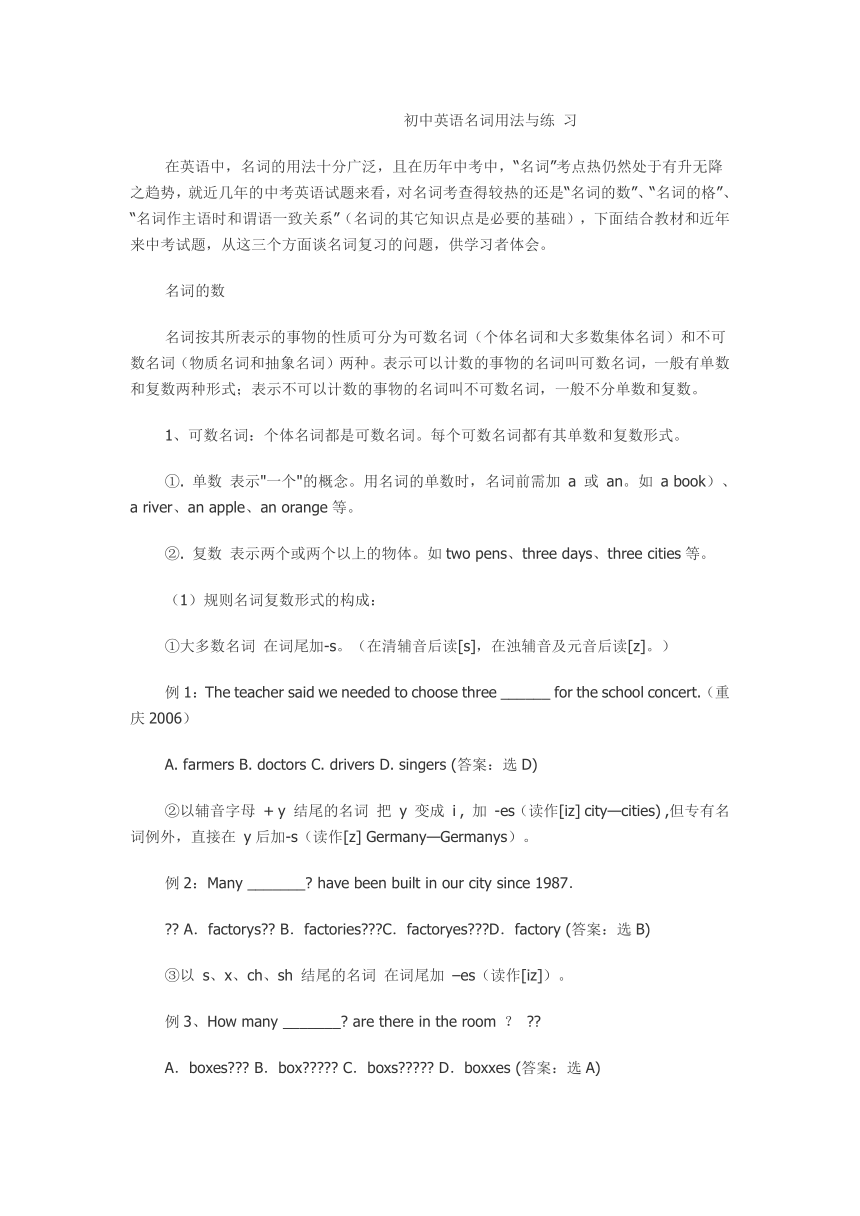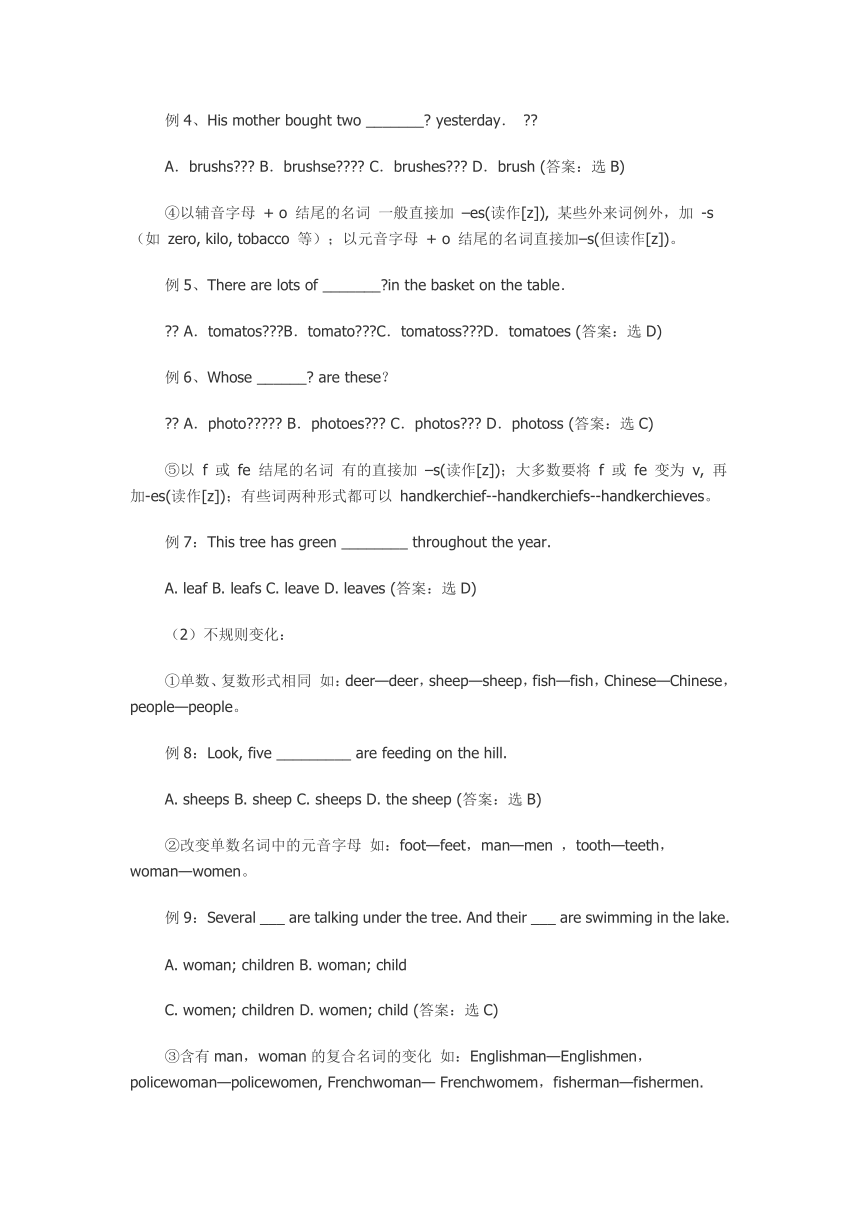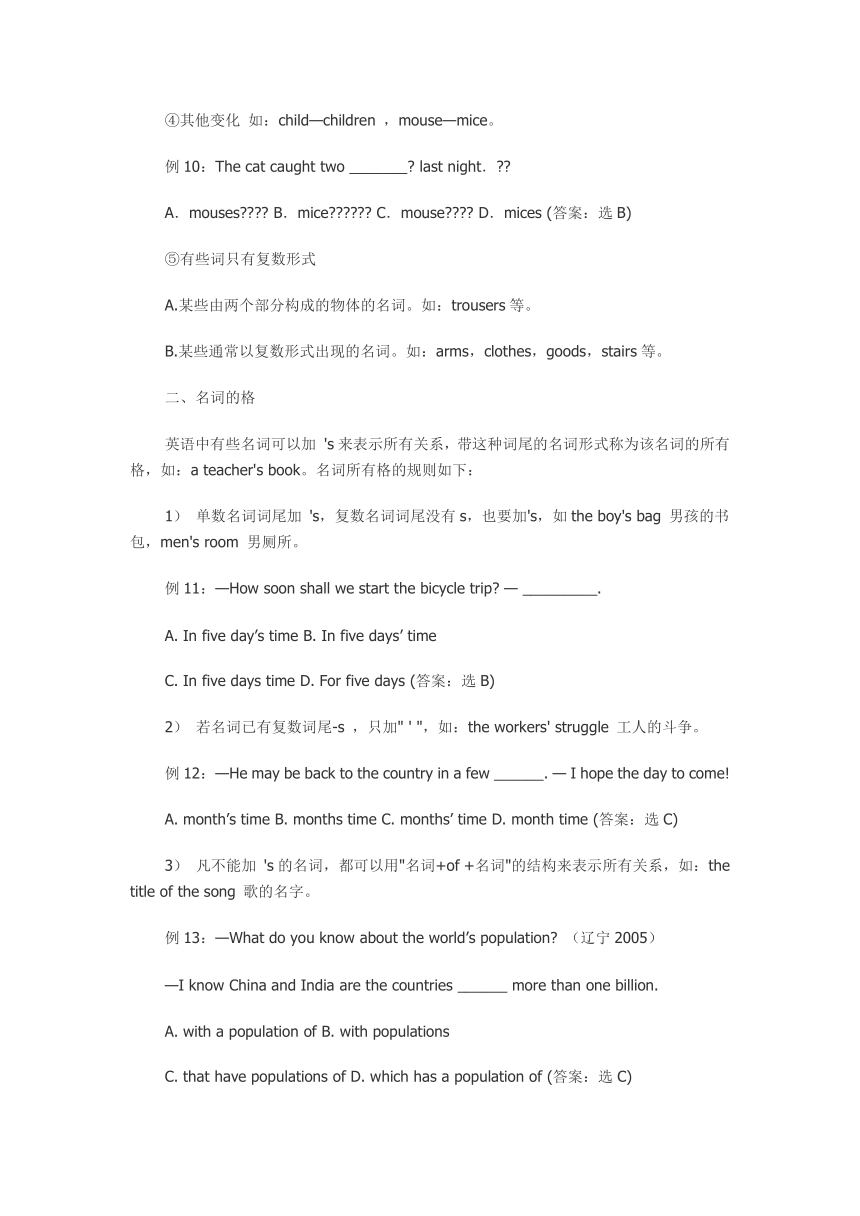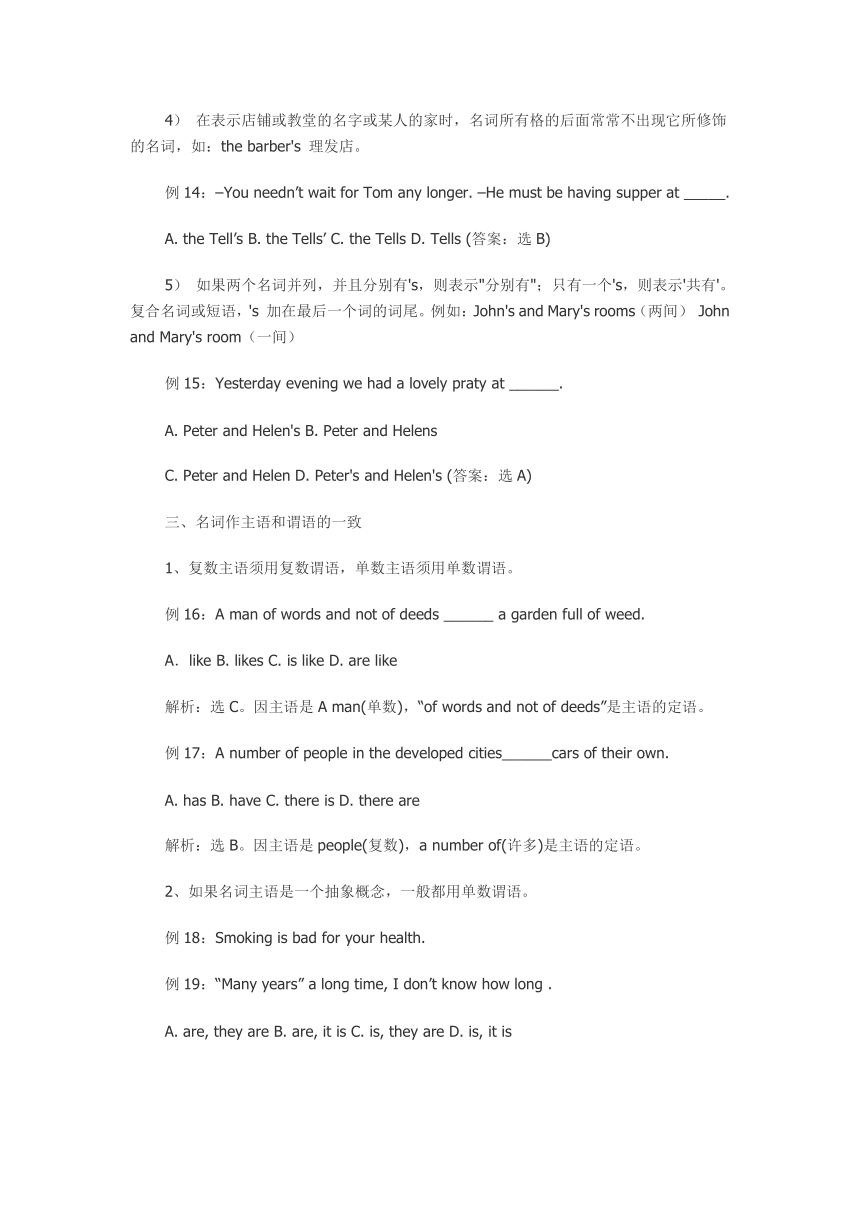初中英语名词用法讲与练
图片预览




文档简介
初中英语名词用法与练 习
在英语中,名词的用法十分广泛,且在历年中考中,“名词”考点热仍然处于有升无降之趋势,就近几年的中考英语试题来看,对名词考查得较热的还是“名词的数”、“名词的格”、“名词作主语时和谓语一致关系”(名词的其它知识点是必要的基础),下面结合教材和近年来中考试题,从这三个方面谈名词复习的问题,供学习者体会。
名词的数
名词按其所表示的事物的性质可分为可数名词(个体名词和大多数集体名词)和不可数名词(物质名词和抽象名词)两种。表示可以计数的事物的名词叫可数名词,一般有单数和复数两种形式;表示不可以计数的事物的名词叫不可数名词,一般不分单数和复数。
1、可数名词:个体名词都是可数名词。每个可数名词都有其单数和复数形式。
①. 单数 表示"一个"的概念。用名词的单数时,名词前需加 a 或 an。如 a book)、a river、an apple、an orange等。
②. 复数 表示两个或两个以上的物体。如two pens、three days、three cities等。
(1)规则名词复数形式的构成:
①大多数名词 在词尾加-s。(在清辅音后读[s],在浊辅音及元音后读[z]。)
例1:The teacher said we needed to choose three ______ for the school concert.(重庆2006)
A. farmers B. doctors C. drivers D. singers (答案:选D)
②以辅音字母 + y 结尾的名词 把 y 变成 i , 加 -es(读作[iz] city—cities) ,但专有名词例外,直接在 y后加-s(读作[z] Germany—Germanys)。
例2:Many _______ have been built in our city since 1987.
A.factorys B.factories C.factoryes D.factory (答案:选B)
③以 s、x、ch、sh 结尾的名词 在词尾加 –es(读作[iz])。
例3、How many _______ are there in the room ?
A.boxes B.box C.boxs D.boxxes (答案:选A)
例4、His mother bought two _______ yesterday.
A.brushs B.brushse C.brushes D.brush (答案:选B)
④以辅音字母 + o 结尾的名词 一般直接加 –es(读作[z]), 某些外来词例外,加 -s (如 zero, kilo, tobacco 等);以元音字母 + o 结尾的名词直接加–s(但读作[z])。
例5、There are lots of _______ in the basket on the table.
A.tomatos B.tomato C.tomatoss D.tomatoes (答案:选D)
例6、Whose ______ are these?
A.photo B.photoes C.photos D.photoss (答案:选C)
⑤以 f 或 fe 结尾的名词 有的直接加 –s(读作[z]);大多数要将 f 或 fe 变为 v, 再加-es(读作[z]);有些词两种形式都可以 handkerchief--handkerchiefs--handkerchieves。
例7:This tree has green ________ throughout the year.
A. leaf B. leafs C. leave D. leaves (答案:选D)
(2)不规则变化:
①单数、复数形式相同 如:deer—deer,sheep—sheep,fish—fish,Chinese—Chinese,people—people。
例8:Look, five _________ are feeding on the hill.
A. sheeps B. sheep C. sheeps D. the sheep (答案:选B)
②改变单数名词中的元音字母 如:foot—feet,man—men ,tooth—teeth,woman—women。
例9:Several ___ are talking under the tree. And their ___ are swimming in the lake.
A. woman; children B. woman; child
C. women; children D. women; child (答案:选C)
③含有man,woman的复合名词的变化 如:Englishman—Englishmen,policewoman—policewomen, Frenchwoman— Frenchwomem,fisherman—fishermen.
④其他变化 如:child—children ,mouse—mice。
例10:The cat caught two _______ last night.
A.mouses B.mice C.mouse D.mices (答案:选B)
⑤有些词只有复数形式
A.某些由两个部分构成的物体的名词。如:trousers等。
B.某些通常以复数形式出现的名词。如:arms,clothes,goods,stairs等。
二、名词的格
英语中有些名词可以加 's来表示所有关系,带这种词尾的名词形式称为该名词的所有格,如:a teacher's book。名词所有格的规则如下:
1) 单数名词词尾加 's,复数名词词尾没有s,也要加's,如the boy's bag 男孩的书包,men's room 男厕所。
例11:—How soon shall we start the bicycle trip — _________.
A. In five day’s time B. In five days’ time
C. In five days time D. For five days (答案:选B)
2) 若名词已有复数词尾-s ,只加" ' ",如:the workers' struggle 工人的斗争。
例12:—He may be back to the country in a few ______. — I hope the day to come!
A. month’s time B. months time C. months’ time D. month time (答案:选C)
3) 凡不能加 's的名词,都可以用"名词+of +名词"的结构来表示所有关系,如:the title of the song 歌的名字。
例13:—What do you know about the world’s population (辽宁2005)
—I know China and India are the countries ______ more than one billion.
A. with a population of B. with populations
C. that have populations of D. which has a population of (答案:选C)
4) 在表示店铺或教堂的名字或某人的家时,名词所有格的后面常常不出现它所修饰的名词,如:the barber's 理发店。
例14:–You needn’t wait for Tom any longer. –He must be having supper at _____.
A. the Tell’s B. the Tells’ C. the Tells D. Tells (答案:选B)
5) 如果两个名词并列,并且分别有's,则表示"分别有";只有一个's,则表示'共有'。复合名词或短语,'s 加在最后一个词的词尾。例如:John's and Mary's rooms(两间) John and Mary's room(一间)
例15:Yesterday evening we had a lovely praty at ______.
A. Peter and Helen's B. Peter and Helens
C. Peter and Helen D. Peter's and Helen's (答案:选A)
三、名词作主语和谓语的一致
1、复数主语须用复数谓语,单数主语须用单数谓语。
例16:A man of words and not of deeds ______ a garden full of weed.
A.like B. likes C. is like D. are like
解析:选C。因主语是A man(单数),“of words and not of deeds”是主语的定语。
例17:A number of people in the developed cities______cars of their own.
A. has B. have C. there is D. there are
解析:选B。因主语是people(复数),a number of(许多)是主语的定语。
2、如果名词主语是一个抽象概念,一般都用单数谓语。
例18:Smoking is bad for your health.
例19:“Many years” a long time, I don’t know how long .
A. are, they are B. are, it is C. is, they are D. is, it is
解析:例1中,smoking指事,谓语用单数;例2选D,因为在英语里,表时间、距离等的名词作主语,和表事件都是抽象概念,其谓语都要用单数。
3、当主语是and连接的两个名词时,在指一样东西时用单数谓语,若指两样东西时则需用复数主语。
例20:Talking about something and doing it are two different things.
例21:I want bread and milk instead of bread and butter because bread and butter not sold well before.
A. are B. is C. were D. was
解析:例1中“说”和“做”是两件事;例2中,bread and milk、bread and butter分别是指“牛奶面包”和“黄油面包”,and连接的表示一样东西,在because从句中,主语bread and butter当然是单数,所以选D。
4、如果名词主语后面跟有with, together with, as well as, except这类词引导的短语,谓语仍用单数,因为这种结构多为修饰语。
例22:Mary with her parents TV in the sitting-room at this time yesterday.
A. is B. are C. was D. were
解析:选C。因为with her parents在此作伴随状语,主语(Mary)是单数。
5、集体名词作主语的情况:
A. 有些集体名词可跟单数谓语,也可跟复数谓语,视作整体时跟单数谓语,着重于所包含的成员时,则可跟复数谓语。
例23:His family lunch at the table now.(have)
例24:His family very poor before.(be)
解析:例1中family指家中成员的活活动,视为复数,填are having;例2中family指“家”,视为整体,是单数,填was。
B. 有些集体名词都指复数的人或动物,后面都用复数谓语。
例25:The police are going to question him. 警察审视他。
解析:在英语里,people, police, media(媒体),bacteria(细菌),cattle(牛群)等名词指复数的人或物。
C.有些集体名词后面的谓语用单数或复数都可以,也有的集体名词通常只跟单数谓语。
[练习]
一、用括号中动词的适当形式填空:
1.One in four people worldwide (be) without good homes.
2.The police (say) the killing of the young man was an accident.
3.Her family (have) been in Los Angeles since the turn of the century.
4.Polities (be) seen as a man’s world, but difficult for women to get on.
5.Broadcast(广播) news (be) true, but not interesting.
6.The United Nations (have) asked for help from the international community.
二、单项选择填空:
1.We need some more . Can you go and get some, please
A. potato B. potatos C. potatoes D. potatoe
2.What big ____ the tiger has!
A. tooth B. teeth C. tooths D. toothes
3.Please remember to give the horse some tree______.
A. leafs B. leaves C. leaf D. leave
4.On the table there are five_____.
A. tomatos B. piece of tomatoes C. tomatoes D. tomato
5.He gave us_____ on how to keep fit.
A. some advices B. some advice C. an advice D. a advice
6.When we saw his face, we knew _____ was bad.
A. some news B. a news C. the news D. news
7.He is hungry. Give him ______ to eat.
A. two breads B. two piece of bread C. two pieces of bread D. two pieces breads
8.—How many ___have you got on your farm –I’ve got five.
A. cow B. sheep C. pig D. chicken
9.Some______came to our school for a visit that day.
A. Germans B. Germen C. Germany D.Germanies
10.A group of ______will visit the museum tomorrow.
A. Canadian B. Australian C. Japanese D. American
11.Let’s meet at 7:30 outside the gate of______.
A. the People’s Park B. the Peoples’ Park C. the People Park D. People’s Park
12.There are sixty-seven______ in our school.
A. women’s teacher B. women teachers C. woman teachers D. women teacher
13.September 10th is ______ in China.
A. Teacher’s Day B. Teachers’ Day C. Teacher Day D. Teachers Day
14.Excuse me, where is the ______
A. men’s room B. mens’ room C. men’s rooms D. men rooms
15.The football under the bed is ______ .
A. Lily and Lucy B. Lily’s and Lucy’s C. Lily’s and Lucy D. Lily and Lucy’s
16.In a few _____ time, those mountains will be covered with trees.
A. year B. years’ C. year’s D. years
17.It’s about _____ walk from my house.
A. ten minute B. ten minutes’ C. ten minute’s D. ten minutes
18.Half _____ telephone calls are made in English.
A. the world B. world C. the world’s D. world’s
19.Miss Smith is a friend of ______ .
A. Mary’s mother’s B. Mary’s mother C. mother’s of Mary D. Mary mother’s
20.Have you seen Tom’s and John’s ______
A. pencil-box B. pencil-box C. pencil-box D. pencils-box
[Keys]
一、提示:有些名词以单数形式出现,但实为复数。1.are 2.say 3.have 提示:有些名词常以-s形式出现,但实为单数。4.is 5.is 6.has
二、1—5: CBBCB; 6—10: CCBAC 11—15: ABBAD 16—20: BBCAB
名词复习
语言实践与内容梳理:
名词的种类
名词分为专有名词和普通名词。专有名词指某个人、地方、机构等特定名词,如Lucy,Beijing等;普通名词一般指一类人或东西,或是一个抽象的概念的名称。从四方面掌握A.个体名词,如worker,book等;B.集体名词,如family,class等;C.物质名词,如glass,coffee等;D.抽象名词,如life,love等。其中个体名词和集体名词合成为可数名词,物质名词和抽象名词合成为不可数名词。
名词的数
不可数名词,包括物质名词和抽象名词,从某种意义不能计数,只有单数形式。可数名词,包括个体名词和集体名词,通常有单复数的区别。可数名词的复数形式一般在单数后面加-s构成,加-s词尾的主要方式有以下几点:⑴一般在词尾直接加-s,如books,boys等。⑵以s、x、ch、sh结尾的名词后加-es,如buses,boxes ,watches等。⑶以辅音字母加“y”结尾的名词,变“y”为“i”,再加-es,如family —families, story—stories,city—cities等。⑷以f,fe结尾的名词通常变f,fe为v,让后再加-es,如knife—knives,wife—wives等。(注意:以o结尾的名词变复数,不同的语法教材对此规定不一。为记忆方便,一般认为:初中教材常见的单词,如tomato—tomatoes, potato —potatoes。其他 photo— photos, radio—radios ,piano —pianos, kilo— kilos ,zoo— zoos等。)
少数名词有不规则复数形式,如:man—men, woman—women, foot—feet, child—children, tooth—teeth, mouse—mice等。
一些名词单复数形式相同,如Chinese, Japanese, deer, sheep, people, cattle,fish等。还有些名词通常以复数形式出现,如clothes,glasses,thanks,noodles等。在two men doctors, some women nurses这类短语中更要注意此处的men,women的用法问题了。
名词的格
名词的格,分主格、宾格以及所有格。名词主宾格在句法上没有拼写区别,一般不作为学习的重点。名词的所有格指有些名词可以在后面加’s来表示所有关系。如露西的书包,Lucy’s bag 。名词的所有格一般在后面加’s,如上例,还有一些其他表现形式⑴一个名词如其复数形式以s结尾,直接在s后打“’ ”,如the students’ books。⑵如其复数形式特殊,不以s结尾,在后加’s,如Children’s Day。⑶如一个东西为两者共有,只在第二者后加’s,表现为A and B’s ,例This is Lily and Lucy’s room. ⑷如两者分别拥有,则分别加’s,表现为A ’s and B’s,如These are Lily’s and Lucy’s rooms
名词所有格主要用于表示有生命的东西的名词,但如表示时间、距离、国家、城市、团体等无生命的名词,也可以用在后加’s的方法,如ten minutes’ walk, today’s news, the People’s cinema等。凡不能加’s的名词,都可以与of构成所有关系,如the map of China, the name of the movie等。
双重所有格是一种特殊形式,of结构与名词所有格-’s结合使用,如a friend of my father’s。of加名词性物主代词也可以构成双重所有格,如a friend of mine。
在英语中,名词的用法十分广泛,且在历年中考中,“名词”考点热仍然处于有升无降之趋势,就近几年的中考英语试题来看,对名词考查得较热的还是“名词的数”、“名词的格”、“名词作主语时和谓语一致关系”(名词的其它知识点是必要的基础),下面结合教材和近年来中考试题,从这三个方面谈名词复习的问题,供学习者体会。
名词的数
名词按其所表示的事物的性质可分为可数名词(个体名词和大多数集体名词)和不可数名词(物质名词和抽象名词)两种。表示可以计数的事物的名词叫可数名词,一般有单数和复数两种形式;表示不可以计数的事物的名词叫不可数名词,一般不分单数和复数。
1、可数名词:个体名词都是可数名词。每个可数名词都有其单数和复数形式。
①. 单数 表示"一个"的概念。用名词的单数时,名词前需加 a 或 an。如 a book)、a river、an apple、an orange等。
②. 复数 表示两个或两个以上的物体。如two pens、three days、three cities等。
(1)规则名词复数形式的构成:
①大多数名词 在词尾加-s。(在清辅音后读[s],在浊辅音及元音后读[z]。)
例1:The teacher said we needed to choose three ______ for the school concert.(重庆2006)
A. farmers B. doctors C. drivers D. singers (答案:选D)
②以辅音字母 + y 结尾的名词 把 y 变成 i , 加 -es(读作[iz] city—cities) ,但专有名词例外,直接在 y后加-s(读作[z] Germany—Germanys)。
例2:Many _______ have been built in our city since 1987.
A.factorys B.factories C.factoryes D.factory (答案:选B)
③以 s、x、ch、sh 结尾的名词 在词尾加 –es(读作[iz])。
例3、How many _______ are there in the room ?
A.boxes B.box C.boxs D.boxxes (答案:选A)
例4、His mother bought two _______ yesterday.
A.brushs B.brushse C.brushes D.brush (答案:选B)
④以辅音字母 + o 结尾的名词 一般直接加 –es(读作[z]), 某些外来词例外,加 -s (如 zero, kilo, tobacco 等);以元音字母 + o 结尾的名词直接加–s(但读作[z])。
例5、There are lots of _______ in the basket on the table.
A.tomatos B.tomato C.tomatoss D.tomatoes (答案:选D)
例6、Whose ______ are these?
A.photo B.photoes C.photos D.photoss (答案:选C)
⑤以 f 或 fe 结尾的名词 有的直接加 –s(读作[z]);大多数要将 f 或 fe 变为 v, 再加-es(读作[z]);有些词两种形式都可以 handkerchief--handkerchiefs--handkerchieves。
例7:This tree has green ________ throughout the year.
A. leaf B. leafs C. leave D. leaves (答案:选D)
(2)不规则变化:
①单数、复数形式相同 如:deer—deer,sheep—sheep,fish—fish,Chinese—Chinese,people—people。
例8:Look, five _________ are feeding on the hill.
A. sheeps B. sheep C. sheeps D. the sheep (答案:选B)
②改变单数名词中的元音字母 如:foot—feet,man—men ,tooth—teeth,woman—women。
例9:Several ___ are talking under the tree. And their ___ are swimming in the lake.
A. woman; children B. woman; child
C. women; children D. women; child (答案:选C)
③含有man,woman的复合名词的变化 如:Englishman—Englishmen,policewoman—policewomen, Frenchwoman— Frenchwomem,fisherman—fishermen.
④其他变化 如:child—children ,mouse—mice。
例10:The cat caught two _______ last night.
A.mouses B.mice C.mouse D.mices (答案:选B)
⑤有些词只有复数形式
A.某些由两个部分构成的物体的名词。如:trousers等。
B.某些通常以复数形式出现的名词。如:arms,clothes,goods,stairs等。
二、名词的格
英语中有些名词可以加 's来表示所有关系,带这种词尾的名词形式称为该名词的所有格,如:a teacher's book。名词所有格的规则如下:
1) 单数名词词尾加 's,复数名词词尾没有s,也要加's,如the boy's bag 男孩的书包,men's room 男厕所。
例11:—How soon shall we start the bicycle trip — _________.
A. In five day’s time B. In five days’ time
C. In five days time D. For five days (答案:选B)
2) 若名词已有复数词尾-s ,只加" ' ",如:the workers' struggle 工人的斗争。
例12:—He may be back to the country in a few ______. — I hope the day to come!
A. month’s time B. months time C. months’ time D. month time (答案:选C)
3) 凡不能加 's的名词,都可以用"名词+of +名词"的结构来表示所有关系,如:the title of the song 歌的名字。
例13:—What do you know about the world’s population (辽宁2005)
—I know China and India are the countries ______ more than one billion.
A. with a population of B. with populations
C. that have populations of D. which has a population of (答案:选C)
4) 在表示店铺或教堂的名字或某人的家时,名词所有格的后面常常不出现它所修饰的名词,如:the barber's 理发店。
例14:–You needn’t wait for Tom any longer. –He must be having supper at _____.
A. the Tell’s B. the Tells’ C. the Tells D. Tells (答案:选B)
5) 如果两个名词并列,并且分别有's,则表示"分别有";只有一个's,则表示'共有'。复合名词或短语,'s 加在最后一个词的词尾。例如:John's and Mary's rooms(两间) John and Mary's room(一间)
例15:Yesterday evening we had a lovely praty at ______.
A. Peter and Helen's B. Peter and Helens
C. Peter and Helen D. Peter's and Helen's (答案:选A)
三、名词作主语和谓语的一致
1、复数主语须用复数谓语,单数主语须用单数谓语。
例16:A man of words and not of deeds ______ a garden full of weed.
A.like B. likes C. is like D. are like
解析:选C。因主语是A man(单数),“of words and not of deeds”是主语的定语。
例17:A number of people in the developed cities______cars of their own.
A. has B. have C. there is D. there are
解析:选B。因主语是people(复数),a number of(许多)是主语的定语。
2、如果名词主语是一个抽象概念,一般都用单数谓语。
例18:Smoking is bad for your health.
例19:“Many years” a long time, I don’t know how long .
A. are, they are B. are, it is C. is, they are D. is, it is
解析:例1中,smoking指事,谓语用单数;例2选D,因为在英语里,表时间、距离等的名词作主语,和表事件都是抽象概念,其谓语都要用单数。
3、当主语是and连接的两个名词时,在指一样东西时用单数谓语,若指两样东西时则需用复数主语。
例20:Talking about something and doing it are two different things.
例21:I want bread and milk instead of bread and butter because bread and butter not sold well before.
A. are B. is C. were D. was
解析:例1中“说”和“做”是两件事;例2中,bread and milk、bread and butter分别是指“牛奶面包”和“黄油面包”,and连接的表示一样东西,在because从句中,主语bread and butter当然是单数,所以选D。
4、如果名词主语后面跟有with, together with, as well as, except这类词引导的短语,谓语仍用单数,因为这种结构多为修饰语。
例22:Mary with her parents TV in the sitting-room at this time yesterday.
A. is B. are C. was D. were
解析:选C。因为with her parents在此作伴随状语,主语(Mary)是单数。
5、集体名词作主语的情况:
A. 有些集体名词可跟单数谓语,也可跟复数谓语,视作整体时跟单数谓语,着重于所包含的成员时,则可跟复数谓语。
例23:His family lunch at the table now.(have)
例24:His family very poor before.(be)
解析:例1中family指家中成员的活活动,视为复数,填are having;例2中family指“家”,视为整体,是单数,填was。
B. 有些集体名词都指复数的人或动物,后面都用复数谓语。
例25:The police are going to question him. 警察审视他。
解析:在英语里,people, police, media(媒体),bacteria(细菌),cattle(牛群)等名词指复数的人或物。
C.有些集体名词后面的谓语用单数或复数都可以,也有的集体名词通常只跟单数谓语。
[练习]
一、用括号中动词的适当形式填空:
1.One in four people worldwide (be) without good homes.
2.The police (say) the killing of the young man was an accident.
3.Her family (have) been in Los Angeles since the turn of the century.
4.Polities (be) seen as a man’s world, but difficult for women to get on.
5.Broadcast(广播) news (be) true, but not interesting.
6.The United Nations (have) asked for help from the international community.
二、单项选择填空:
1.We need some more . Can you go and get some, please
A. potato B. potatos C. potatoes D. potatoe
2.What big ____ the tiger has!
A. tooth B. teeth C. tooths D. toothes
3.Please remember to give the horse some tree______.
A. leafs B. leaves C. leaf D. leave
4.On the table there are five_____.
A. tomatos B. piece of tomatoes C. tomatoes D. tomato
5.He gave us_____ on how to keep fit.
A. some advices B. some advice C. an advice D. a advice
6.When we saw his face, we knew _____ was bad.
A. some news B. a news C. the news D. news
7.He is hungry. Give him ______ to eat.
A. two breads B. two piece of bread C. two pieces of bread D. two pieces breads
8.—How many ___have you got on your farm –I’ve got five.
A. cow B. sheep C. pig D. chicken
9.Some______came to our school for a visit that day.
A. Germans B. Germen C. Germany D.Germanies
10.A group of ______will visit the museum tomorrow.
A. Canadian B. Australian C. Japanese D. American
11.Let’s meet at 7:30 outside the gate of______.
A. the People’s Park B. the Peoples’ Park C. the People Park D. People’s Park
12.There are sixty-seven______ in our school.
A. women’s teacher B. women teachers C. woman teachers D. women teacher
13.September 10th is ______ in China.
A. Teacher’s Day B. Teachers’ Day C. Teacher Day D. Teachers Day
14.Excuse me, where is the ______
A. men’s room B. mens’ room C. men’s rooms D. men rooms
15.The football under the bed is ______ .
A. Lily and Lucy B. Lily’s and Lucy’s C. Lily’s and Lucy D. Lily and Lucy’s
16.In a few _____ time, those mountains will be covered with trees.
A. year B. years’ C. year’s D. years
17.It’s about _____ walk from my house.
A. ten minute B. ten minutes’ C. ten minute’s D. ten minutes
18.Half _____ telephone calls are made in English.
A. the world B. world C. the world’s D. world’s
19.Miss Smith is a friend of ______ .
A. Mary’s mother’s B. Mary’s mother C. mother’s of Mary D. Mary mother’s
20.Have you seen Tom’s and John’s ______
A. pencil-box B. pencil-box C. pencil-box D. pencils-box
[Keys]
一、提示:有些名词以单数形式出现,但实为复数。1.are 2.say 3.have 提示:有些名词常以-s形式出现,但实为单数。4.is 5.is 6.has
二、1—5: CBBCB; 6—10: CCBAC 11—15: ABBAD 16—20: BBCAB
名词复习
语言实践与内容梳理:
名词的种类
名词分为专有名词和普通名词。专有名词指某个人、地方、机构等特定名词,如Lucy,Beijing等;普通名词一般指一类人或东西,或是一个抽象的概念的名称。从四方面掌握A.个体名词,如worker,book等;B.集体名词,如family,class等;C.物质名词,如glass,coffee等;D.抽象名词,如life,love等。其中个体名词和集体名词合成为可数名词,物质名词和抽象名词合成为不可数名词。
名词的数
不可数名词,包括物质名词和抽象名词,从某种意义不能计数,只有单数形式。可数名词,包括个体名词和集体名词,通常有单复数的区别。可数名词的复数形式一般在单数后面加-s构成,加-s词尾的主要方式有以下几点:⑴一般在词尾直接加-s,如books,boys等。⑵以s、x、ch、sh结尾的名词后加-es,如buses,boxes ,watches等。⑶以辅音字母加“y”结尾的名词,变“y”为“i”,再加-es,如family —families, story—stories,city—cities等。⑷以f,fe结尾的名词通常变f,fe为v,让后再加-es,如knife—knives,wife—wives等。(注意:以o结尾的名词变复数,不同的语法教材对此规定不一。为记忆方便,一般认为:初中教材常见的单词,如tomato—tomatoes, potato —potatoes。其他 photo— photos, radio—radios ,piano —pianos, kilo— kilos ,zoo— zoos等。)
少数名词有不规则复数形式,如:man—men, woman—women, foot—feet, child—children, tooth—teeth, mouse—mice等。
一些名词单复数形式相同,如Chinese, Japanese, deer, sheep, people, cattle,fish等。还有些名词通常以复数形式出现,如clothes,glasses,thanks,noodles等。在two men doctors, some women nurses这类短语中更要注意此处的men,women的用法问题了。
名词的格
名词的格,分主格、宾格以及所有格。名词主宾格在句法上没有拼写区别,一般不作为学习的重点。名词的所有格指有些名词可以在后面加’s来表示所有关系。如露西的书包,Lucy’s bag 。名词的所有格一般在后面加’s,如上例,还有一些其他表现形式⑴一个名词如其复数形式以s结尾,直接在s后打“’ ”,如the students’ books。⑵如其复数形式特殊,不以s结尾,在后加’s,如Children’s Day。⑶如一个东西为两者共有,只在第二者后加’s,表现为A and B’s ,例This is Lily and Lucy’s room. ⑷如两者分别拥有,则分别加’s,表现为A ’s and B’s,如These are Lily’s and Lucy’s rooms
名词所有格主要用于表示有生命的东西的名词,但如表示时间、距离、国家、城市、团体等无生命的名词,也可以用在后加’s的方法,如ten minutes’ walk, today’s news, the People’s cinema等。凡不能加’s的名词,都可以与of构成所有关系,如the map of China, the name of the movie等。
双重所有格是一种特殊形式,of结构与名词所有格-’s结合使用,如a friend of my father’s。of加名词性物主代词也可以构成双重所有格,如a friend of mine。
同课章节目录
- 词法
- 名词
- 动词和动词短语
- 动词语态
- 动词时态
- 助动词和情态动词
- 非谓语动词
- 冠词
- 代词
- 数词和量词
- 形容词副词及其比较等级
- 介词和介词短语
- 连词和感叹词
- 构词法
- 相似、相近词比较
- 句法
- 陈述句
- 一般疑问句和否定疑问句
- 特殊疑问句及选择疑问句
- 反意疑问句
- 存在句(There be句型)
- 宾语从句
- 定语从句
- 状语从句
- 主谓一致问题
- 简单句
- 并列句
- 复合句
- 主谓一致
- 主、表语从句
- 名词性从句
- 直接引语和间接引语
- 虚拟语气
- 感叹句
- 强调句
- 倒装句
- 祈使句
- 句子的成分
- 句子的分类
- 题型专区
- 单项选择部分
- 易错题
- 完形填空
- 阅读理解
- 词汇练习
- 听说训练
- 句型转换
- 补全对话
- 短文改错
- 翻译
- 书面表达
- 任务型阅读
- 语法填空
- 其他资料
